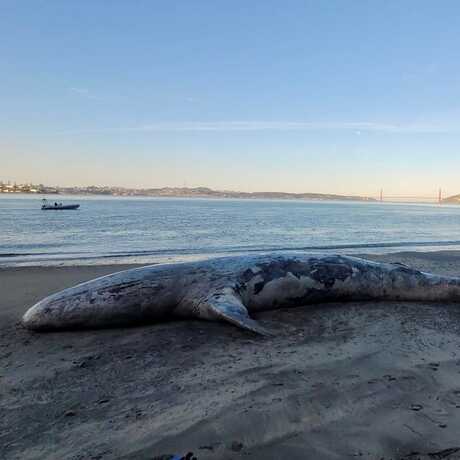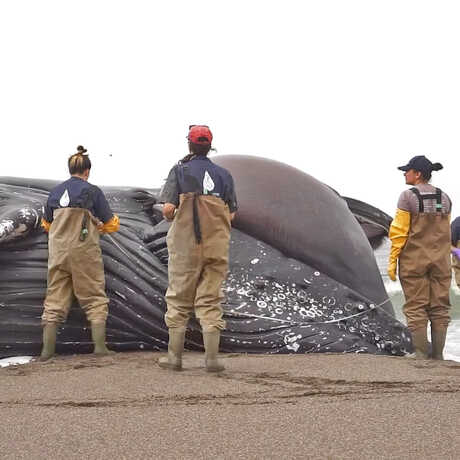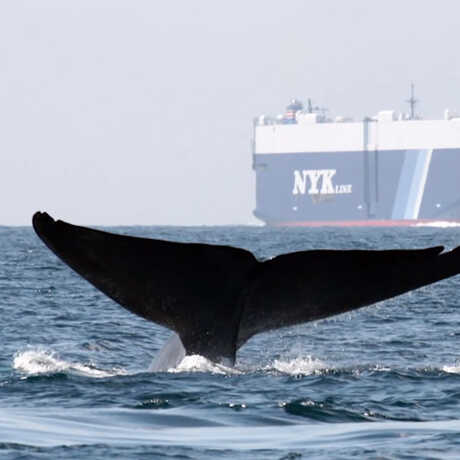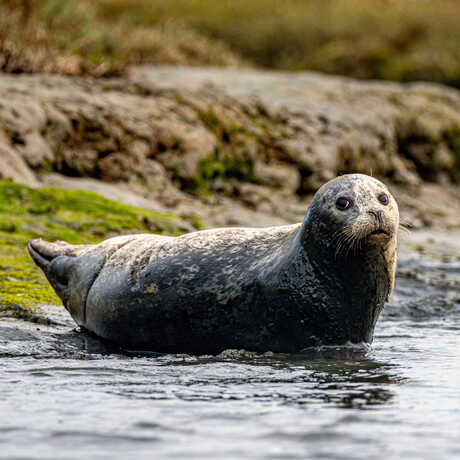Scientist Spotlight
Moe Flannery
Moe Flannery describes herself as a librarian, but instead of lending books, she manages and takes care of over 150,000 bird and mammal specimens as the Academy’s Senior Collections Manager of Ornithology and Mammalogy. Flannery joined the Academy in 2002 and is responsible for expanding her department’s collections and elevating the Academy’s profile within the Marine Mammal Stranding Network. Today, Flannery is an expert in large mammal necropsies and scientific specimen curation, and is passionate about the intersections of public education and scientific research.
How did you become interested in the study of birds and mammals, and what led you to a career in conservation science?

My story is super crazy: I have undergraduate degrees in Asian and Women’s Studies, and then I had a career in theater. Yet throughout this time, I always loved biology. I gave up on it in college because of how hard and massive first-year classes were. Instead, I spent 10 years working in theater, handling the technical side of lighting and design.
Eventually, when I was in my late 20s, I got into birding with a local nonprofit, and I realized there was this whole field of environmental sciences and birding that hadn’t been available to me before. I started taking supplemental classes to fill out my knowledge of biology and science, and I left my career in theater to become an intern. I landed an internship at what is now called Point Blue Conservation Science and finished a few volunteer field seasons studying puffins in Maine and seabirds on an island in Alaska.
Your earliest project at the Academy involved the China Natural History Project. What was your involvement in this work?

While using the collections for my research on molt patterns, I connected with the collections manager, Doug Long, who let me know that one of his colleagues received a huge grant to do biodiversity collecting in China with all disciplines: birds, small mammals, plants, reptiles and amphibians, fish, maybe even entomology. When he heard I had studied Chinese language in college, he asked me to help collect birds in China, which I quickly agreed to because I understood the scientific value of bird collections. After an Academy research trip to a remote mountain in Burma, which I joined as a volunteer, I was hired as a curatorial assistant in birds and mammals. That expedition was my job interview, basically.
I went on four of six expeditions to China between 2002 and 2006 as part of a great collaboration with the Kunming Institute of Zoology. We worked with a team of Chinese biologists and did field work in remote areas of Western China such as the Gaoligong Mountains. We didn’t end up building collections here as much as we wanted to, but the sheer diversity of birds and mammals was really quite something to see.

Conducting necropsies allows scientists, researchers, and collections managers to better understand what causes marine mammal mortalities, and to expand collections of bones and other specimens. © California Academy of Sciences [All marine mammal stranding activities were conducted under authorization by the National Marine Fisheries Service through a Stranding Agreement issued to the California Academy of Sciences and MMPA/ESA Permit No.18786]
You’re in many ways the face of marine mammal stranding response at the Academy. How did you get involved in this work?
The Academy’s involvement in the Marine Mammal Stranding Network officially began in the 1980s and was led by my predecessor Ray Bandar, an icon in the field. If anyone found a dead animal, they would call Ray’s personal phone number and leave him a message. He was my mentor, teaching me everything I know about marine mammals, necropsies, and stranding response. Today, I’m continuing what Ray first built, though he still supports this work even after his death through a large gift called the Raymond and Alkmene Bandar Endowment, which helps us curate marine mammal specimens. I’ve found additional funding through state and federal Prescott Grants, which helped us purchase equipment for our Bones Lab and invest in more curatorial staff.
We’ve responded to hundreds of stranded whales and pinnipeds, but I think there’s room for growth in large whale necropsy responses up and down the Pacific Coast. Especially with the announcement of the gray whale Unusual Mortality Event in 2019, stranded dead whales became more of a well-recognized problem throughout California. Now, we’re trying to build out our capacity as a network to document and respond more in depth to large whales. It would be amazing to do necropsies in Mexico and neighboring countries that also report large whale strandings—it’s not something I’ve been able to work on but it’s always on my mind because there’s not a lot of capacity elsewhere.
What’s your favorite Academy specimen?

The orca hanging in the front of the Academy. It was such an experience putting that skeleton together, from receiving the initial stranding report, to the first day of response and the multiple bone salvage trips where our team navigated a very remote, dangerous intertidal area in Point Reyes National Seashore, to the weeks of specimen preparation, and finally the articulation in front of our visitors. It was truly a group effort, and every step revealed something new about the whale, who was identified as a known individual, O319. The necropsy gave us little clues about his cause of death, but the process of articulating the orca—in particular observing the broken ribs, arranging his skeleton—put the whole picture in place. And now, there he is, hanging in perpetuity on the Academy’s main floor, representing all of that hard work. It really underscores the need for necropsies, articulations, and public displays.
Who is your science hero?
Ray Bandar, who taught me everything I know about marine mammals. Ray was a scientist, but he was also an artist who really appreciated the different shapes of vertebrates and skulls. His passion for the science and the art of it was also contagious: He loved sharing his “Bone Palace” with people, giving tours of his basement up in Twin Peaks. On my very first day of work at the Academy, in 2002, I worked in the Bone Palace, packing up California sea lion skulls for an exhibit that featured over 800 sea lions on the main wall—all of which Ray had collected. I was immediately immersed in Ray’s world of wonder, and I felt really lucky that I had him to learn from and to catch his contagious bug of marine mammal love.

Ray Bandar was a Bay Area legend known for collecting hundreds of skulls and bones in his at-home Bone Palace. These specimens are now part of the Academy's birds and mammals collections. Gayle Laird © California Academy of Sciences
You have a non-traditional career pathway. What advice would you give to future scientists?
I’ve always said that passion is one of the most important criteria for being a scientist and for working in a museum. Having a non-traditional background also makes you a more well-rounded person and shows that you can pivot in a number of directions. I started with Asian studies, then theater, then bird banding, and then when the need arose for small mammal trapping and marine mammal work, that’s when I stepped in. The degree I never thought I would use actually helped me get the job that became the career for the rest of my life. That’s the thrill of science. You think you’re working on one answer, and then more questions arise. If we don’t keep asking questions, we won't find new answers for how to keep nature as a vital resource for everyone.
Department: Ornithology & Mammalogy
Title: Senior Collections Manager of Ornithology and Mammalogy
Videos:
Preventing Ship Strikes
What Happens When Whales Strand?
Meet Moe Flannery
Related pages:
Marine Mammal Stranding Network
Investigating Strandings, Protecting Whales
For more than 60 years, Academy field associate Raymond Bandar (1927-2017) collected thousands of skulls. In a ten-case display curated by “Bones” Bandar himself, visitors to the Naturalist Center can explore a variety of skulls featuring curious traits and abnormalities.






